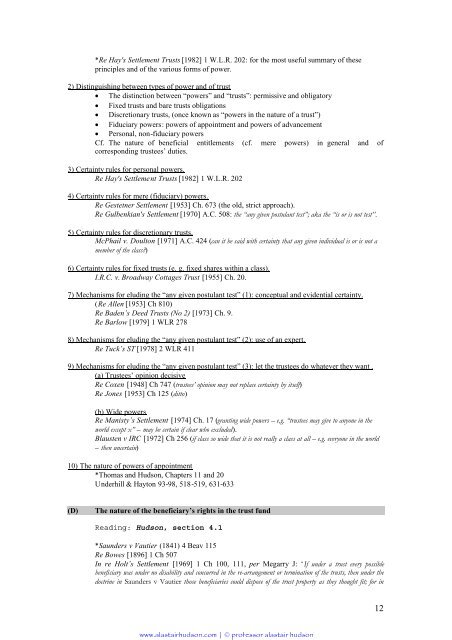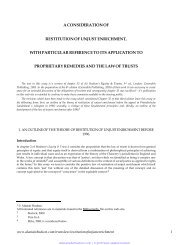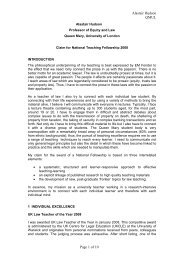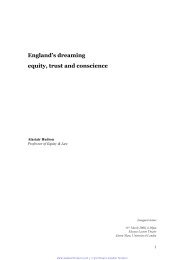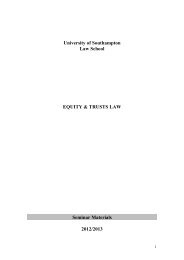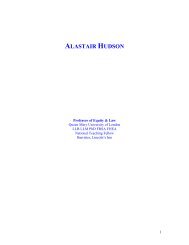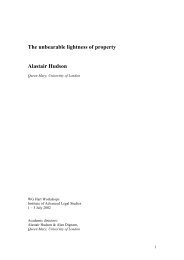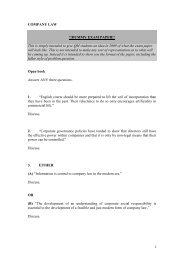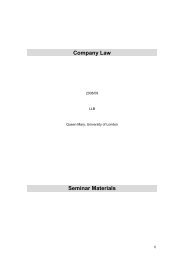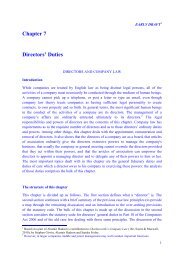Advanced Equity and Trusts Law - alastairhudson.com
Advanced Equity and Trusts Law - alastairhudson.com
Advanced Equity and Trusts Law - alastairhudson.com
Create successful ePaper yourself
Turn your PDF publications into a flip-book with our unique Google optimized e-Paper software.
*Re Hay's Settlement <strong>Trusts</strong> [1982] 1 W.L.R. 202: for the most useful summary of these<br />
principles <strong>and</strong> of the various forms of power.<br />
2) Distinguishing between types of power <strong>and</strong> of trust<br />
� The distinction between “powers” <strong>and</strong> “trusts”: permissive <strong>and</strong> obligatory<br />
� Fixed trusts <strong>and</strong> bare trusts obligations<br />
� Discretionary trusts, (once known as “powers in the nature of a trust”)<br />
� Fiduciary powers: powers of appointment <strong>and</strong> powers of advancement<br />
� Personal, non-fiduciary powers<br />
Cf. The nature of beneficial entitlements (cf. mere powers) in general <strong>and</strong> of<br />
corresponding trustees’ duties.<br />
3) Certainty rules for personal powers.<br />
Re Hay's Settlement <strong>Trusts</strong> [1982] 1 W.L.R. 202<br />
4) Certainty rules for mere (fiduciary) powers.<br />
Re Gestetner Settlement [1953] Ch. 673 (the old, strict approach).<br />
Re Gulbenkian's Settlement [1970] A.C. 508: the “any given postulant test”; aka the “is or is not test”.<br />
5) Certainty rules for discretionary trusts.<br />
McPhail v. Doulton [1971] A.C. 424 (can it be said with certainty that any given individual is or is not a<br />
member of the class?)<br />
6) Certainty rules for fixed trusts (e. g. fixed shares within a class).<br />
I.R.C. v. Broadway Cottages Trust [1955] Ch. 20.<br />
7) Mechanisms for eluding the “any given postulant test” (1): conceptual <strong>and</strong> evidential certainty.<br />
(Re Allen [1953] Ch 810)<br />
Re Baden’s Deed <strong>Trusts</strong> (No 2) [1973] Ch. 9.<br />
Re Barlow [1979] 1 WLR 278<br />
8) Mechanisms for eluding the “any given postulant test” (2): use of an expert.<br />
Re Tuck’s ST [1978] 2 WLR 411<br />
9) Mechanisms for eluding the “any given postulant test” (3): let the trustees do whatever they want .<br />
(a) Trustees’ opinion decisive<br />
Re Coxen [1948] Ch 747 (trustees’ opinion may not replace certainty by itself)<br />
Re Jones [1953] Ch 125 (ditto)<br />
(b) Wide powers<br />
Re Manisty’s Settlement [1974] Ch. 17 (granting wide powers – e.g. “trustees may give to anyone in the<br />
world except x” – may be certain if clear who excluded).<br />
Blausten v IRC [1972] Ch 256 (if class so wide that it is not really a class at all – e.g. everyone in the world<br />
– then uncertain)<br />
10) The nature of powers of appointment<br />
*Thomas <strong>and</strong> Hudson, Chapters 11 <strong>and</strong> 20<br />
Underhill & Hayton 93-98, 518-519, 631-633<br />
(D) The nature of the beneficiary’s rights in the trust fund<br />
Reading: Hudson, section 4.1<br />
*Saunders v Vautier (1841) 4 Beav 115<br />
Re Bowes [1896] 1 Ch 507<br />
In re Holt’s Settlement [1969] 1 Ch 100, 111, per Megarry J: ‘If under a trust every possible<br />
beneficiary was under no disability <strong>and</strong> concurred in the re-arrangement or termination of the trusts, then under the<br />
doctrine in Saunders v Vautier those beneficiaries could dispose of the trust property as they thought fit; for in<br />
www.<strong>alastairhudson</strong>.<strong>com</strong> | © professor alastair hudson<br />
12


